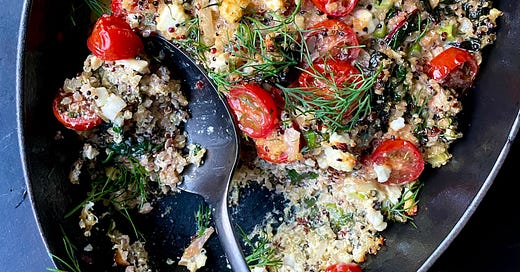Greek Quinoa Bake
A cozy dish that's simple to make and simply packed with nutrients and flavor
Hi, friends! Who among us is expecting snow or ice this weekend? Winter is in full swing, but, I’m noticing a little more light at 5 pm (and 6 am!) so I am reminded that these winter doldrums won’t last forever.
I’m going to be brief this week as I am behind on my book work, but I wanted to share an easy, cozy, versatile, healthy, and surprisingly delicious dish: my Greek Quinoa Bake. It stars Swiss chard, feta, fresh dill, grape tomatoes, and quinoa, of course, and can be served for lunch, brunch, or as a dinner side—though, to be honest, I had it for dinner last night and was very satisfied. Maybe that’s because quinoa is not a grain, even though we use it like one. It’s actually a seed, giving it a higher protein content than most grains and making it a complete protein at that.
Even if you think you don’t like quinoa, I urge you to give this a try. The—ahem—earthy taste of quinoa by itself might not be for everyone, but mixed with other tasty ingredients as it is here, it becomes a blank slate and a great binder.
How to Cook Perfect, Fluffy Quinoa
I would suggest, as I do for most grains, that you use less water than is called for in the “package directions.”
Instead of the standard 2:1 ratio of water to quinoa, I use 1 ¾ cups of water for 1 cup of dry quinoa. It’s a bit drier and fluffier this way, and that’s the way I like it.
Just mix the water and quinoa together in a small saucepan with a little salt, bring it to a boil, stir, and lower to a simmer. Cover the pot and cook for 15 minutes. Let it sit for 5 minutes, then transfer quinoa to a bowl to cool a bit. Fluff it every few minutes, stirring with a fork, as you prep the rest of the ingredients.
You will notice that I call for a cup measure of cooked quinoa rather than dry. I have found the cooked volume can vary depending on the color of quinoa you use and also on the amount of water you use to cook it, and I want the proportions of the dish to be just right. When making this bake, I cook one cup of dry quinoa, measure out the two cups of cooked quinoa that I need, then use the leftovers in a soup or salad. Cooked quinoa keeps well in the fridge for at least three days, if not longer.
Work with What You Have!
There’s room for improvisation in this recipe. I suggest using Swiss chard—and I’ll tell you why in a second—but you can also use spinach or kale, if it is what you have on hand. If you are using spinach, wilt it separately ahead of time and squeeze out any excess moisture before adding it to the recipe (if you don’t, the bake could turn out soggy).
I didn’t put black olives in, but I thought of it afterwards and sprinkled some on top; it was delicious. I recommend buttery oil-cured olives or Kalamata—just chop them and mix them in with the other ingredients.
All in all, this dish has a slightly Greek flavor, with the feta and dill leaning it strongly in the direction of spanakopita. The perennially available and consistently good grape tomatoes add a bright note for a cold winter day!
Spotlight on: Swiss Chard
OK, so why Swiss chard? It may not be the first vegetable you grab in the supermarket, but it’s there (or should be, anyway). It is a lot like spinach, but it doesn’t shrink so much when you cook it, and it doesn’t give off excess moisture like spinach does, so it works more seamlessly in this recipe. As you will see below, you can just wilt it right into the onion mixture. Plus, it’s good for you!
You’ll want to strip the leaves from the stems for this recipe, and one bunch of chard will yield just the right amount. That said, the stems are a vegetable in their own right—don’t throw them out! To include them here, just chop them up and sauté them along with the onions. You could also save them to use later in a soup.
Without further ado, here’s the recipe!




